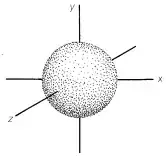In classical electromagnetism, an electron in an orbit due to the Coulomb force around a proton ( the hydrogen atom), would be continually in motion, because of the angular acceleration it would radiate its energy and slowly the radius of the orbit would would become smaller, until the electron fell on the proton. No hydrogen atom, no atoms in general. As experimentally atoms and molecules exist, it became necessary to abandon classical electromagnetism at the micro level. Bohr by imposing ad hoc quantization of the angular momentum, manage to reproduce the spectrum of Hydrogen, creating stable orbits at a given radius.
Thus in the Bohr model, the electron moves from one level to another and the energy/momentum lost or gained is taken or given by an appropriate energy photon.
The Bohr model was superseded by the Schrodinger mode for the Hydrogen atom, which gave the same prediction for the spectra, but has a completely different mathematical basis. There is though correlation between the hypothetical orbits of the Bohr model and the orbitals of the Schrodinger solution.
The orbitals are the loci where the electron with the given (l,n,m) has a finite probability to be found in a measurement, but the average should conform with the Bohr radii. See this for example.
When discussing quantum mechanical states , the concept of motion is not relevant. Look at the hydrogen orbitals"

Fig.6 Representation of the hydrogen 1s orbital
When a photon is absorbed, it is one point in this plot for the electron location, it can be anyplace within the orbital, and occupy any similar single point in the orbital it ends up . It is only averages that could have any meaning.
